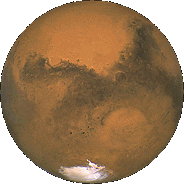
August Editorial

August Editorial
Strange spots on the southern ice cap of Mars. |
|
The Martian atmosphere is composed predominantly (95%) of carbon dioxide, which during the winter, when temperatures drop to minus 130oC, freezes onto the surface of Mars creating a large ice cap. Every spring, strange dark spots (approximately 15 to 45 meters in diameter) appear on the surface of the ice cap. It was thought that as the ice melted the dark ground underneath became visible. However, a paper published on the 17th of August in Nature suggests a different origin for the spots. Dr Kieffer and his colleges from the Arizona State University have analysed almost 200 visible and infrared images which were taken by the Thermal Emission Imaging System (THEMIS) installed by NASA on the Mars Odyssey orbiter. The images allowed scientists to study the ice caps from the winter months through the spring into summer. What they have discovered shows that in early spring the ice cap, which is by then about 3 feet deep, is exposed to the stronger sunlight. The sun penetrates the transparent CO2 and reflects the light from the dark surface underneath. As a result the frozen CO2 turns into gas without first going into the intermediate liquid form (this process is known as sublimation ). CO2 in the form of a gas, accumulates under the frozen surface and eventually breaks through with substantial force creating a high-pressure jet, which includes a mass of dust and sand collected from the Martian surface in the process . The jet moves up into the atmosphere with a speed of about 100mph. The larger particles of material are heavy enough to fall down in a circle around the geyser, which creates the unusual dark spots. The jets continue to erupt until the entire ice slab sublimates and vanishes, exposing the Martian surface. This process repeats itself at the end of each winter again and again. Reference: Hugh H. Kieffer, Philip R. Christensen and Timothy N. Titus. (2006) CO2 jets formed by sublimation beneath translucent slab ice in Mars' seasonal south polar ice cap. Nature, 17 August. |
| _______________________________ | ||||
| Home | | | Shopping | | | Database |
© Biscuit Software 2004-2015
All rights reserved